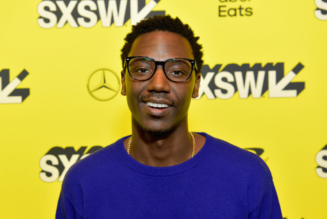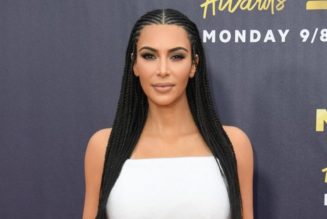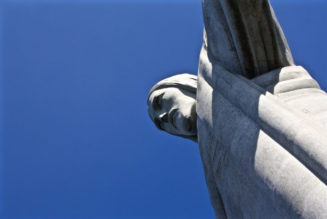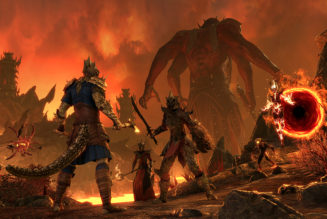One would think that the “hook” of Tom Scharpling’s memoir, It Never Ends would be the fact that he a) was institutionalized for depression and eventually reinvented himself and b) changed his last name from Giuliano — combining the names of two polarizing heroes: Al Sharpton, who Tom admired for his willingness to be a champion for minorities while putting New York on blast for its racism and corruption, and Garry Shandling, whose deadpan, unflappable wit was an early influence on Tom’s comedic sensibility — as a community college student in Middlesex County, New Jersey. However, that’s just the tip of the iceberg for Scharpling, who has quietly influenced and bridged the gap between alternative rock and comedy over the last 25-plus years through the music videos he’s directed, the television shows he’s written, and, most famously, his radio show, The Best Show.
Originally airing on 91.1 WFMU in New Jersey, The Best Show was a music and call-in show until one fateful evening in 1997, when Scharpling’s comedy partner, and drummer extraordinaire Jon Wurster, called in pretending to be Ronald Thomas Clontle, a pretentious music critic who was the author of Rock, Rot, & Rule, a definitive guide to which music artists are terrible, good, and great. Intentionally inflammatory, listeners had no idea that the call was a comedy segment, and phones rang off the hook as angry listeners tried to fight and debunk Wurster’s pompous blowhard.
“I was so nervous about it because we hadn’t done anything like that,” Scharpling says. “It was just working right from the get-go. It was like me plus Jon was like one plus one equals 11. It just felt like this is bigger than the two of us. Something’s clicking here that’s special.”
Over the years, Scharpling and Wurster, who met after a Superchunk concert in the mid-’90s and bonded over a shared love of Chris Eliott’s insane FOX sitcom, Get a Life, have come up with hundreds of characters, from Corey Harris, the delusional singer of the rock band Mother 13, to Philly Boy Roy, a loudmouthed contrarian — a character, arguably, more beloved than any other.
Wurster’s characters are often pretentious and self-aggrandizing, but Philly Boy Roy is perhaps unique in that he loves all things Philadelphia, the sometimes cultural enemy of New Jersey. “It cuts through everything. Everybody is on board with it and everybody wants to see me get punished by Philly Boy Roy, and I do, too,” Scharpling says. “It’s the funniest because, in a way, it’s the most frustrating character to coexist with because he can get away with anything, and everyone wants him to get away with it. It’s like I’m Skyler on Breaking Bad when I’m with Philly Boy Roy, where it’s just like I’m ostensibly the good one, and people are just, ‘we hate you. We want the bad one, not the good one.’ What? I’m a decent person! They’re like ‘you suck! Philly Boy Roy rules!’ He’s objectively a bad human. I get it. I love it too.”
The world of The Best Show is Springfieldian in its expanse of characters and relationships, but each character usually originates from the same wellspring. “It really is just whatever is making us laugh,” Scharpling says. “I mean, there’s not a whole lot of over-intellectualizing about it. We’re just going, here’s a funny thing I want to make fun of, or here’s a funny idea for a character. Or I saw a guy walking down the street. Or overheard a guy at a 7-Eleven. The inspiration can come from anywhere, but then there’s a funny twist on it. If it’s entertaining us, it gets the green light“
The show has had guests from the worlds of comedy and alternative rock, including the likes of Fred Armisen, Marc Maron, Steve Albini and Kurt Vile, and has often served as a bridge from one to the next. This is borne out of Scharpling’s intense music fandom, which resulted in him starting his own zine, Eighteen Wheeler, before the radio show was even a glint in his eye.
The magazine, like the show, was a true DIY project, and that ethos led Scharpling to not only have Aimee Mann and Carl Newman on the show, but direct music videos for them, as well as groups like Wild Flag, The Ettes, Real Estate and The Stepkids.
Scharpling’s videos for Mann’s “Labrador” (a shot-for-shot remake of the ‘Til Tuesday classic “Voices Carry”) and The New Pornographers’ “Moves” were early examples of viral hits. This is partly because Scharpling called on his friends from the New York comedy scene to help out. “Labrador” features Jon Hamm, and “Moves” almost reads as a primer to mid-aughts alternative comedy, with comedians like Wyatt Cenac, Todd Barry, Donald Glover and John Oliver standing in for actual members of the band.
This connection to comedy comes from Scharpling’s involvement in the late ‘90s/early ‘00s New York comedy scene. While he appeared on Late Night with Conan O’Brien when the show was pulling from performers at Upright Citizens Brigade (many who were friends of Scharpling), and wrote for The Onion, he was more part of the scene as an occasional collaborator, rather than a constant performer.
This connection to comedy comes from Scharpling’s involvement in the late ‘90s/early ‘00s New York comedy scene. While he appeared on Late Night with Conan O’Brien when the show was pulling from performers at Upright Citizens Brigade (many who were friends of Scharpling), and wrote for The Onion, he was more part of the scene as an occasional collaborator, rather than a constant performer.
In addition to the radio show and directing, Scharpling is also a television writer. While he got started on Monk starring Tony Shalhoub (“One of the kindest, most professional people I’ve ever worked with”), he’s also written for the Tim & Eric Awesome Show precursor, Tom Goes to the Mayor, as well as Divorce, Difficult People, and What We Do in the Shadows. Working on Difficult People allowed Scharpling to work with his other longtime comedy collaborator, Julie Klausner, who also helped him with an Adult Swim infomercial and sort-of-Best Show-spinoff, The Newbridge Tourism Board Presents: “We’re Newbridge. We’re Comin’ to Get Ya!” The infomercial had the makings of another early viral hit, but was unfortunately overshadowed by Too Many Cooks, an early viral hit for Adult Swim that parodies the opening credits of ‘70s, ‘80s and ‘90s opening credits before devolving into a slasher film. Recently, Scharpling had some attention when he posted a mock-up script for Grown Ups 3, a film that doesn’t exist, and may never be released. Not bad for a guy from New Jersey, right?
SPIN: How has New Jersey factored into your career?
Tom Scharpling: An enormous part of everything I do is shaped by New Jersey. It always will be — and I’m happy about that. I have a tremendous amount of pride to have New Jersey be this kind of foundational experience. And yeah, it does a certain thing to you because you’re right there looking at New York, and then you got Philly below — these two gigantic forces you’re sandwiched between, and you’re neither of them. So you have two chips on your shoulder. Philly people have a chip on their shoulder about New York, and we have a chip on our shoulder about Philly and New York.
You mention being obsessed with music as a kid, seeing R.E.M. and other alt-rock shows that were pivotal to moments in your life. As a shy individual, what do you feel that scene offered you in terms of community, ethics, and other things that shaped you?
Coming out of the indie scene would be you can just go do something if you want to do it. You don’t have to wait for some larger entity or corporation to give you permission. You just start figuring your business out, and you’re allowed to do that. You also have a different perspective on what success is, what failure is, and what they aren’t.
I remember when that first Pavement single came out. It was like this is the best band on the planet right now. It doesn’t matter that they’re not as big as the Red Hot Chili Peppers. That’s the indie thing. If it’s good, it’s good. The conventional versions of success don’t apply. And that’s something that meant a lot to me, because then I didn’t feel like I was failing if I was doing good stuff, no matter who was or wasn’t on board.
Apart from R.E.M. and Pavement, what do you remember as being significant influences on your musical life when you realized you wanted to get into radio? How has that meaning held up for you over the years?
There were so many bands that meant a lot to me. I couldn’t name them all, but there was inspiration everywhere. You turn around and there’s a new great band that is advancing the language. Love Child, Unrest, Big Dipper, Volcano Suns, Dinosaur Jr, Galaxie 500, Barbara Manning/World of Pooh… all of these bands were great enough to be absolutely massive at a different time, but the whole indie rock divide kinda kept bands from breaking through to the mainstream. But the pre-Nirvana world was much preferable to the post-Nirvana world because on the whole major labels weren’t clogging up the works and the promise of millions of dollars simply wasn’t in the mix.
Do you find that when you’re listening to new music you can appreciate it for what it is, or do you have a hard time avoiding comparisons to older acts?
I don’t know. You want to just take it on a case-by-case basis and try to not prefigure certain people, because then it’s nice when you’re surprised by where they go. Look at Angel Olsen, she’s like Bruce Springsteen to me because she’s doing her thing, and it’s going to be whatever she wants it to be. She can do a breathy, quiet thing, and then she can do a thing that’s pre-rock, rock and roll. And she could do things with strings. She can do whatever she wants. It’s a funny thing.
I’m glad the performers don’t put themselves in the boxes that a lot of critics put people in. Or not even just critics, just fans that are trying to figure it out.
The other day I heard a band that made me think this is just Velocity Girl all over again, like Olivia Tremor Control 2.0. I think that’s neat that there’s all these younger musicians doing stuff like that, but it takes a lot of effort.
The one thing that’s exciting to me is when somebody in their 20s doesn’t even know that reference. And that’s how whoever was influenced by Olivia Tremor Control or Velocity Girl or whoever it is, could be influenced by the person that was immediately influenced by them, and that’s where they were getting it from. Or maybe they jumped over Olivia Tremor Control and were influenced by kind of ‘60s psych stuff. Like right back to the source with it. And then suddenly there’s a band that was doing something like what you were doing 20 years ago. And then they’re like, “oh, wow, look at this. There’s a lineage here, and we’re not even aware of every one we’re on the continuum with. But we’re a part of it.” That’s how it feels with so much stuff where it’s like doing radio or comedy.
Obviously, The Best Show predates things like Comedy Bang Bang, where comedians and musicians can be booked to do something interesting. What do you think it is about The Best Show that attracted comics and musicians to it?
The show was perfect for bands to listen to while on tour — just long enough to keep people in a van occupied for a few hours. These people make stuff and they want the best from their entertainment so they come to The Best Show! Too arrogant? Eh, what can I do? When I act too modest it quickly becomes me beating myself up and when I add a little confidence to the mix then I come off like a braggart.
What do you remember about playing Sasquatch with Jon Wurster?.
That was a disaster. We ate shit hard that day. Nobody wanted comedy, and they really didn’t want what we were selling. That was kind of spectacular in how badly it went. And I kind of cherish that moment actually because it was a real bonding thing with me and Jon. We were just looking at each other. And we’re just like these people are coming into this comedy tent because it’s providing shade. They want nothing to do with what we’re saying on stage. And it was kind of magical to go all the way from New Jersey to Seattle for a free 45-to-one-hour performance, just to bomb and get back on a plane and go back home.
If it’s all fans of your work, I think that’s always the ideal thing.
Well, for the live stuff, especially. We knew that we were figuring out how that worked. We’re just like, where’s the entry point for people, how little can they know about us and then get into it. We found out that it needs to be more than that. People are just like, “why are these two guys doing something that I do not understand?” And it’s also a festival. It’s corny. Everything at a festival is representative of what it would be in an actual thing. You go see a band, it’s kind of like you didn’t see them. You saw them do their festival thing. And when you go see someone that you care about, and they’re the headliners at their own show. A festival is like the audience’s night with all these rotating people showing up, so attendees can just checklist who they saw and be like, “I saw them, I saw them, I saw them.” And you can say you saw them. You didn’t see a real show by them. You saw a festival show by them.
Tell me how you met Julie Klausner.
I met Julie when The Best Show was a couple of years in, and she came up to the studio with another friend, Andrew Earls, and the second I met her, I knew she was the real deal, a heavyweight in terms of comedy. The first conversation we had, I was like, “oh, this is a truly, truly funny person who is just legit.” You meet a lot of people, and people can be very funny, but it’s not often that you meet somebody where you’re like, “oh, you’re so going to be somebody.”
Is your partnership with her similar to what you have with Jon, where you just trust this person and you click comedically? Or is there something inherent where, you know, you can collaborate?
I’d say it’s probably both. When you have chemistry with somebody you feel like you can go somewhere with them, and you can trust them as a partner to go somewhere, and you know you’re building the same thing. Does that make sense? I never really put words to it, but I think that’s what it is. The goal is to build the same thing. And that’s what our thing is like,
There’s kind of like this trifecta of viral videos that you make at the time, because it’s Aimee Mann’s “Labrador,” the Ted Leo video “Bottled in Cork,” and then it’s also The New Pornographers “Moves.” Did you always have the ambition to direct music videos, or was that something you just went to?
I always wanted to try my hand at it. I always loved funny videos, and video director Phil Morrison is one of my best friends. He’s been a constant inspiration to me. My friend Peyton Reed is the same thing. He’s a director who I always admire. I didn’t go to film school and I didn’t have the proper education, but I did feel like I had been writing for television long enough. I know what’s funny, I know when it looks funny. I might not be able to talk about camera lenses, but if somebody can help me with the language of this, I can do what I do, and my thing can translate to this. I knew I had it in me.
If I waited for somebody to give me permission to do any of this stuff, none of it would ever happen. I’m not qualified for any of this. I didn’t go to broadcasting school, so why should I have a radio show? I didn’t go to any writing program, so why should I call myself a writer? You just got to go do them, but you gotta be your own college in a way.
At this point, do you find that your ambitions keep shifting because you’ve done quite a lot?
Well, that’s very nice of you to say. I think I’m going to try to get back into directing, and I think I’m going to try to do longer stuff. I want to do some videos to build back my muscles in that way, because I’ve been so focused on writing for the last couple of years. I do want to get my chops back, and I want to write something that I would direct that would be a feature. That would be my next big target for my professional life.
The thing that is consistent in your life is The Best Show. When you were writing the book, did you think about what that has added to New Jersey culture?
I guess it’s just a thing… I’m from New Jersey and it’s hard to say. It’s like it’s just something that somebody from New Jersey did, and it was about someone from New Jersey. I guess it turned into a thing that’s big in terms of the length of time I’ve been doing it, but it was always one week at a time. If somebody asked me to sign a contract to do this for half my life, I would have not done it, especially with most of it being for free. But when it’s one week at a time, it’s “I’ll try that. I’ll do it this week,” and they would do it for a little bit. Then it’s, “Yeah, let’s keep doing it.” Then you turn around and it’s telling the story of my own life in this very consistent, unique way where I was there almost every week for half my life. It’s going to represent the story of somebody from New Jersey who’s living their life.
I’m always proud of New Jersey. It really shaped so many things in the right way. It’s not an accident that you can look at the list of people who are from New Jersey and be like, wow, so many of the artists that have shaped everything came from this state because it’s kind of a sweet spot for cultivating you. You’re not in the middle of nowhere. You’re an hour away from Broadway, and all the museums and culture. Then you’re also not in it all the time. You immediately get your feet planted on the ground because it’s not a fabulous place 24/7.











